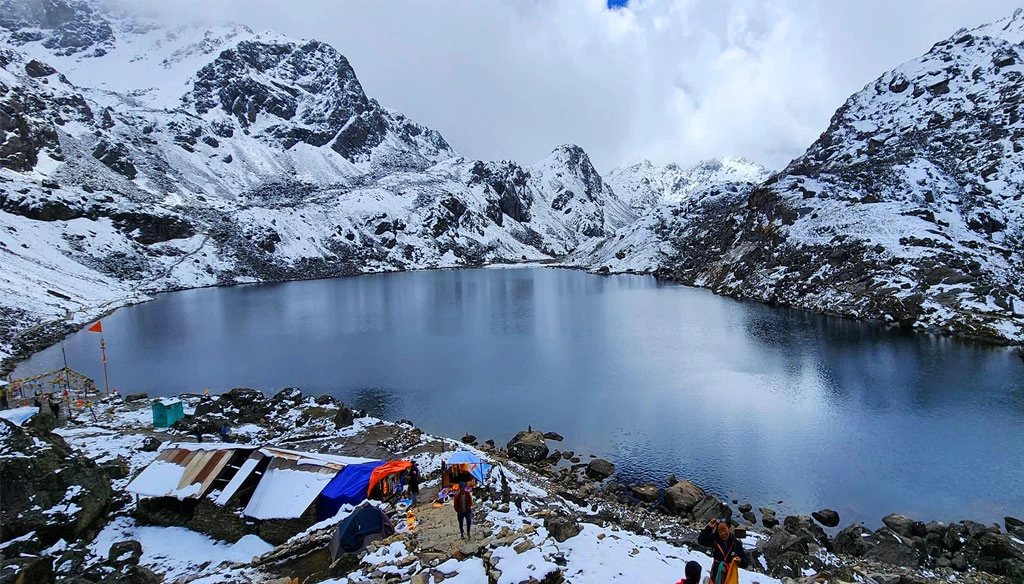Your cart is currently empty!
Part I: The Escape
Kathmandu has its own kind of gravity. It’s a city that pulls you in with a chaotic embrace, a whirlwind of sound, dust, and history. The drone of traffic is constant, the air thick with the scent of incense and exhaust fumes, and every alleyway holds a story. For those of us born and raised here, it is the rhythm of life itself. But sometimes, that rhythm becomes a relentless drumbeat, and the soul yearns for silence. It was on a particularly hazy afternoon, sitting on a rooftop overlooking the sprawling city, that the idea for our trek was born. The distant, hazy outline of the Himalayas, barely visible through the smog, seemed to be calling to us.
My friend and I weren’t seeking a hardcore expedition or a record-breaking ascent. We were seeking an escape. We wanted to trade the concrete labyrinth for open trails, the blare of horns for the whisper of the wind, and the complexities of city life for the simple, profound truths of the mountains. Langtang felt right. It was close, yet it promised a world of difference. It was known as the “Valley of Glaciers,” a place of raw, untamed beauty, and home to the resilient Tamang people. It was a chance to reconnect not just with nature, but with a part of our own Nepali heritage that often feels distant from the urban sprawl of the capital.
The Road to Syabrubesi
The drive from Kathmandu to Syabrubesi is not for the faint of heart. It’s a bone-jarring, gut-wrenching, and utterly unforgettable experience. Our journey began before dawn, the city still cloaked in a pre-dawn gloom. The bus, a vibrant, and slightly battered, vessel of hope and humanity, was already packed to the gills. We squeezed in, our backpacks precariously perched on the roof, and surrendered ourselves to the journey. As we lurched out of the city, the landscape began to transform. The urban chaos gave way to terraced hillsides, emerald green with rice paddies, and small villages clinging to the slopes. The road, a narrow ribbon of asphalt and dirt, twisted and turned, hugging the mountainside with a terrifying intimacy. At times, it felt as though we were suspended between the heavens and the earth, with a sheer drop to the valley below. The driver, a master of his craft, navigated the treacherous bends with a calm nonchalance, his hand perpetually on the horn, a symphony of toots and blares that announced our presence to the world. It was a prelude to the challenges ahead, a test of patience and resilience, and a reminder that in Nepal, the journey is always an integral part of the adventure.

Night Walks & Moonlit Trails
Some of our most memorable moments happened after the sun went down. On clearer nights, the moon was so bright it cast long shadows across the trail. We met other trekkers in these quiet hours, their headlamps like distant stars, sharing a few words in the vast, silent wilderness.
The Simple Comforts
As we gained altitude, the landscape changed. Just as memorable as the views was the food. After a long day, nothing felt more satisfying than a simple, steaming plate of dal bhat and curried potatoes. In the cold mountain air, it tasted like the most delicious meal on earth, a cherished ritual that replenished both body and soul.

A Sacred Encounter
Our journey culminated at the sacred Gosaikunda Lake. The sight of the crystal-clear turquoise waters was breathtaking. On the final push, we found our own ritual. Sharing some locally grown weed, we felt a surge of energy and a deeper connection to the raw, wild nature around us, making the arduous climb feel almost effortless.

Reflections on the Trail
Our seven-day trek was more than a physical challenge; it was a journey of self-discovery. We missed the famed “Tibetan glacier view” due to fog, but it taught us a valuable lesson: trekking is about the journey, not just the destination.
We returned to Kathmandu with tired bodies but rejuvenated spirits. The mountains have a way of putting things into perspective, of reminding us of what truly matters.

Leave a Reply